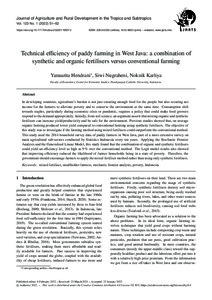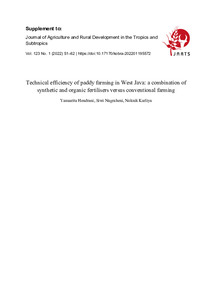Technical efficiency of paddy farming in West Java: a combination of synthetic and organic fertilisers versus conventional farming
| dc.date.accessioned | 2022-02-14T14:08:19Z | |
| dc.date.available | 2022-02-14T14:08:19Z | |
| dc.date.issued | 2022-02-08 | |
| dc.identifier | doi:10.17170/kobra-202201195572 | |
| dc.identifier.uri | http://hdl.handle.net/123456789/13613 | |
| dc.language.iso | eng | eng |
| dc.rights | Namensnennung 4.0 International | * |
| dc.rights.uri | http://creativecommons.org/licenses/by/4.0/ | * |
| dc.subject | mixed fertilisers | eng |
| dc.subject | smallholder farmers | eng |
| dc.subject | stochastic frontier analysis | eng |
| dc.subject | poverty | eng |
| dc.subject | Indonesia | eng |
| dc.subject.ddc | 630 | |
| dc.title | Technical efficiency of paddy farming in West Java: a combination of synthetic and organic fertilisers versus conventional farming | eng |
| dc.type | Aufsatz | |
| dcterms.abstract | In developing countries, agriculture’s burden is not just ensuring enough food for the people but also securing net income for the farmers to alleviate poverty and to conserve the environment at the same time. Consumption shift towards staples, particularly during economic crisis or pandemic, requires a policy that could make food growers respond to the demand appropriately. Initially, from soil science, an argument asserts that mixing organic and synthetic fertilisers can increase yield/productivity and be safe for the environment. Previous studies showed that, on average organic farming produced lower yield compared to conventional farming using synthetic fertilisers. The objective of this study was to investigate if the farming method using mixed fertilisers could outperform the conventional method. This study used the 2014 household survey data of paddy farmers in West Java, part of a more extensive survey on main agricultural sub-sectors conducted by Statistics Indonesia every ten years. Applying the Stochastic Frontier Analysis and the Generalised Linear Model, this study found that the combination of organic and synthetic fertilisers could yield an efficiency level as high as 9% over the conventional method. The Logit model results also showed that improving efficiency reduced the likelihood of farmer households being in a state of poverty. Therefore, the government should encourage farmers to apply the mixed fertiliser method rather than using only synthetic fertilisers. | eng |
| dcterms.accessRights | open access | |
| dcterms.creator | Hendrani, Yanuarita | |
| dcterms.creator | Nugraheni, Siwi | |
| dcterms.creator | Karliya, Noknik | |
| dc.subject.swd | Indonesien | ger |
| dc.subject.swd | Kleinbauer | ger |
| dc.subject.swd | Mehrnährstoffdünger | ger |
| dc.subject.swd | Frontier-Funktion | ger |
| dc.subject.swd | Armut | ger |
| dc.subject.swd | Einkommen | ger |
| dc.subject.swd | Grundnahrungsmittel | ger |
| dc.type.version | publishedVersion | |
| dcterms.source.identifier | eissn:2363-6033 | |
| dcterms.source.issue | No. 1 | |
| dcterms.source.journal | Journal of Agriculture and Rural Development in the Tropics and Subtropics (JARTS) | eng |
| dcterms.source.pageinfo | 51-62 | |
| dcterms.source.volume | Vol. 123 | |
| kup.iskup | false |
Dateien zu dieser Ressource
Das Dokument erscheint in:
-
Vol 123, No 1 (2022) [14]



